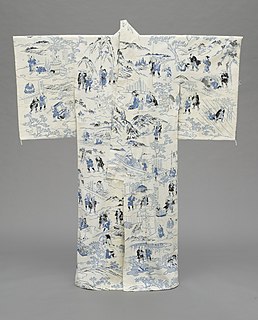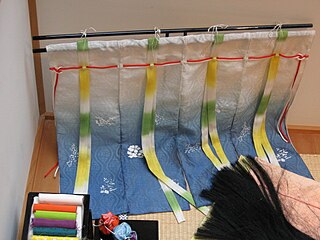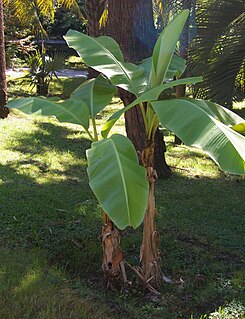 W
WBingata is a traditional stencilled resist dyeing technique originating in Okinawa Prefecture. Bingata typically features a busy pattern of repeating nature motifs such as fish, flowers and fauna in a number of bright colours. Bingata is worn during traditional Ryukyuan festivals and traditional arts performances.
 W
WBoro (ぼろ) are a class of Japanese textiles that have been mended or patched together. The term is derived from the Japanese term "boroboro", meaning something tattered or repaired. The term 'boro' typically refers to cotton, linen and hemp materials, mostly hand-woven by peasant farmers, that have been stitched or re-woven together to create an often many-layered material used for warm, practical clothing.
 W
WFukusa , are a type of Japanese textile used for gift-wrapping or for purifying equipment during a Japanese tea ceremony. Fukusa are square or almost square pieces of lined fabric ranging in size from about 9 inches to 36 inches on a side. Their use has mostly died out, lingering mainly in certain ritual exchanges of gifts during weddings in a few regions of Japan.
 W
WFuroshiki are traditional Japanese wrapping cloths traditionally used to wrap and/or to transport goods. Unlike tenugui, greater consideration is placed on the aesthetics of furoshiki, which may feature hemmed edges, thicker and more expensive materials, and hand-painted designs. While they come in a variety of sizes, they are typically square. Traditional materials include silk or cotton, but modern furoshiki are available in synthetic materials like rayon, nylon, or polyester.
 W
WIse katagami (伊勢型紙) is the Japanese craft of making paper stencils for dyeing textiles. It is designated one of the Important Intangible Cultural Properties of Japan. The art is traditionally centered on the city of Suzuka in Mie Prefecture. This is good for making a certain shape or picture within your project. It is different from Ise washi though both are made in Mie Prefecture.
 W
WThe Kariyushi shirt is a style of dress shirt originating in Okinawa Prefecture, Japan. Similar to aloha shirts, these shirts are mainly worn in summer. The shirts are printed, mostly short-sleeved, and collared. Kariyushi shirts may be worn as casual, informal wear, or as dresswear. First introduced in 1970 to promote tourism to Okinawa Prefecture, the style gained popularity in 2000 when heads of state wore them during the 26th G8 summit which was held in Okinawa. These shirts are promoted as part of the Cool Biz campaign by the Government of Japan.
 W
WKasuri (絣) is the Japanese term for fabric that has been woven with fibers dyed specifically to create patterns and images in the fabric, typically referring to fabrics produced within Japan using this technique. It is a form of ikat dyeing, traditionally resulting in patterns characterized by their blurred or brushed appearance.
 W
WKatazome (型染め) is a Japanese method of dyeing fabrics using a resist paste applied through a stencil, typically a rice flour mixture applied with a brush or a tool such as a palette knife. Unlike yūzen, stencils are used repeatedly to make a repeating pattern. Pigment is added by hand-painting, immersion dyeing, or both. The area of the fabric covered and permeated by the paste mixture resists the later application of dye, thus creating undyed areas within the fabric.
 W
WA kichō (几帳) is a portable multi-paneled silk partition supported by a T-pole. It came into use in aristocratic households during and following the Heian period in Japan when it became a standard piece of furniture. They are similar in appearance to a kabeshiro, but are mounted on a free-standing stand rather than a lintel beam. They are less similar to noren, which do not include streamers to tie them up, and are generally used in different social settings.
 W
WKijōka-bashōfu (喜如嘉の芭蕉布) is the Japanese craft of making cloth from the bashō or Japanese fibre banana as practiced in Kijōka in Ogimi, Okinawa. Like linen, hemp, ramie and other long vegetable fibres, it does not stick to the skin in hot weather; as such it is suitable for the climate of Okinawa. Kijōka-bashōfu is recognized as one of the Important Intangible Cultural Properties of Japan.
 W
WKogin-zashi (こぎん刺し) is one of the techniques of sashiko, or traditional Japanese decorative reinforcement stitching, that originated in the part of present-day Aomori Prefecture controlled by the Tsugaru clan during the Edo period (1603-1867). It is also referred to as sashi-kogin.
 W
WKumihimo is a traditional Japanese artform of making braids and cords. Literally meaning "gathered threads", kumihimo are made by interlacing reels of yarn, commonly silk, with the use of traditional, specialised looms - either a marudai (丸台) or a takadai (高台).
 W
WNishijin-ori is a traditional textile produced in the Nishijin (西陣) district of Kamigyō-ku in Kyoto, Japan.
 W
WNoren (暖簾) are traditional Japanese fabric dividers hung between rooms, on walls, in doorways, or in windows. They usually have one or more vertical slits cut from the bottom to nearly the top of the fabric, allowing for easier passage or viewing. Noren are rectangular and come in many different materials, sizes, colors, and patterns.
 W
WRōketsuzome, sometimes shortened to rōzome, is a traditional wax-resist textile dyeing technique in Japan, akin to Indonesian batik.
 W
WSaga Nishiki is a form of brocading from Saga Prefecture, Japan. It is a unique form of brocading in that Japanese paper is used as the warp. This paper is coated in either gold, silver or lacquer. The weft is a silk thread which is dyed. As the technique is time-consuming, only several inches are produced each day.
 W
WSashiko is a type of traditional Japanese embroidery or stitching used for the decorative and/or functional reinforcement of cloth and clothing. Owing to the relatively cheap nature of white cotton thread and the abundant nature of cheap, indigo-dyed blue cloth in historical Japan, sashiko has a distinctive appearance of white-on-blue embroidery, though some decorative pieces may also use red thread.
 W
WShibori is a Japanese manual tie-dyeing technique, which produces a number of different patterns on fabric.
 W
WTemari balls are a folk art form and Japanese craft, originating in China and introduced to Japan around the 7th century A.D. "Temari" means "hand ball" in Japanese. Balls made from embroidery may be used in handball games and other such similar games. An accessory similar in appearance, but with the addition of a hand-strap and a tassel, can serve as an accessory for a kimono; a kimono bag.
 W
WA tsuitate (衝立) is a form of single-panel portable partition traditionally used in Japan since at least the 6th century. They may be made of wood, or a wood frame covered in paper or silk cloth. The panels are often illustrated, with paintings on both sides, sometimes by well-known artists. The wood frame may be lacquered, and pricier tsuitate may be very richly decorated, including use of precious metals.
 W
WTsujigahana (辻ヶ花) is a Japanese fabric dyeing technique that originated in the Muromachi period.
 W
WTsutsugaki (筒描) is a Japanese technique of resist dyeing that involves drawing rice-paste designs on cloth, dyeing the cloth, and then washing off the paste.
 W
WYūzen (友禅染) is a Japanese resist dyeing technique where dyes are applied inside outlines of dyed or undyed rice-paste resist, which may be drawn freehand or stencilled; the paste keeps the dye areas separated. Originating in the 17th century, the technique became popular as both a way of subverting sumptuary laws on dress fabrics, and also as a way to quickly produce kimono that appeared to be painted freehand with dyes. The technique was named after Miyazaki Yūzen, a 17th century fan painter who perfected the technique. Miyazaki Yūzen's fan designs became so popular that a book called the yūzen-hiinagata was published in 1688, showing similar patterns applied to kosode. A fashion for elaborate pictoralyūzen designs lasted until 1692.